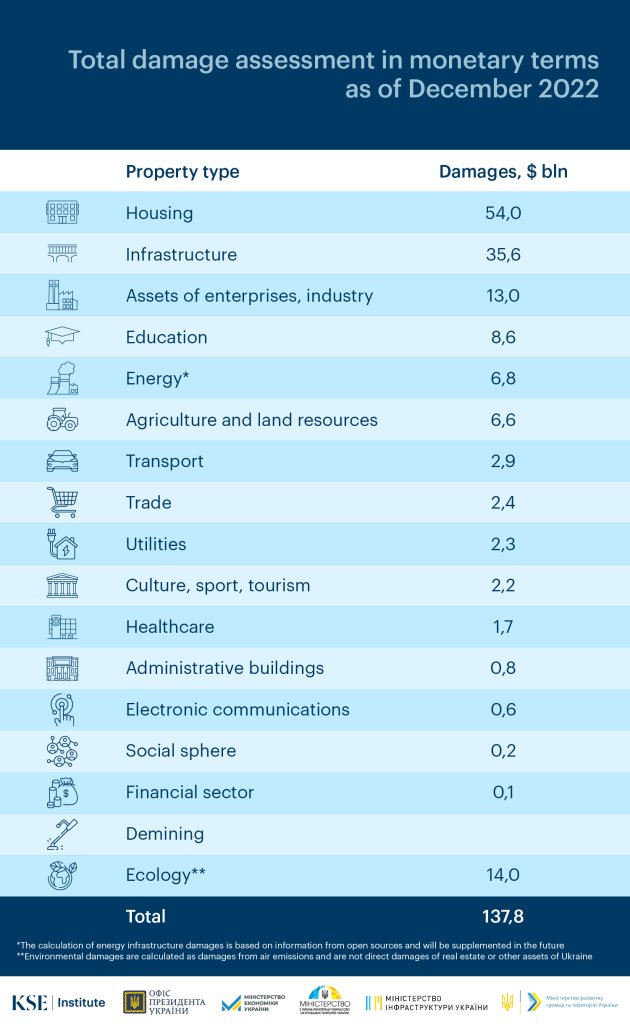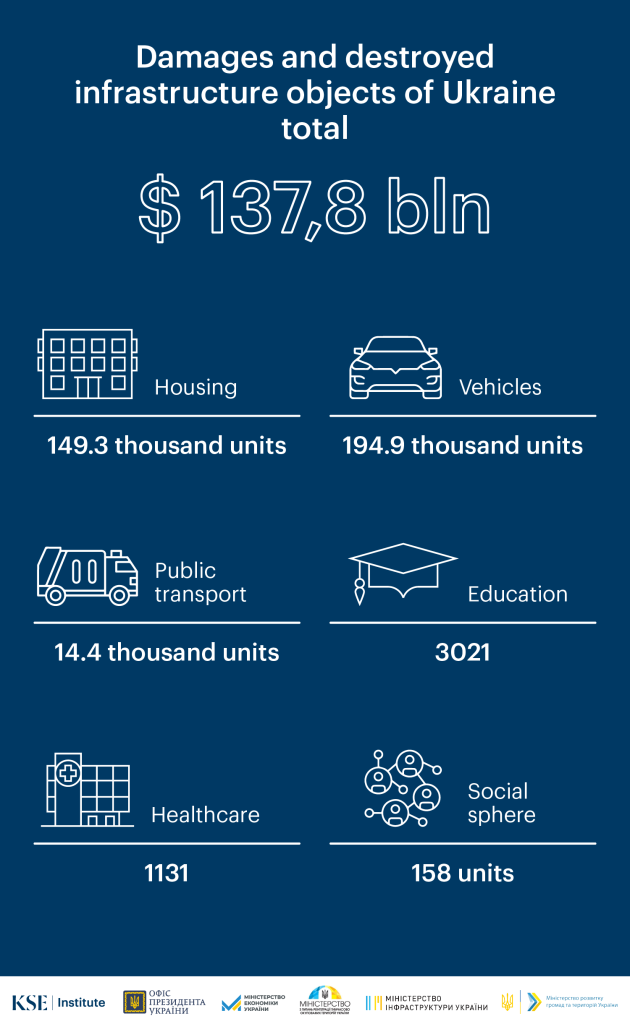- Kyiv School of Economics
- About the School
- News
- The total amount of damage caused to Ukraine’s infrastructure due to the war has increased to almost $138 billion
The total amount of damage caused to Ukraine’s infrastructure due to the war has increased to almost $138 billion
24 January 2023
As of December 2022, the total amount of documented damage to Ukraine’s infrastructure due to the full-scale invasion launched by Russia on February 24, 2022, is estimated at $137.8 billion (at replacement cost).
The damage assessment was carried out within the framework of the National Council for the Recovery of Ukraine from the Consequences of the War by the analytical team of the Kyiv School of Economics (KSE) supported by the UK’s Government (UK Aid) together with the Ministry of Community Development and Territories, the Ministry of Infrastructure, the Ministry of Health, under the coordination of the Ministry of Reintegration Temporarily Occupied Territories and in cooperation with other relevant ministries and the National Bank of Ukraine.
Compared to the latest estimates as of November 2022, the total amount of damage has increased by almost $2 billion. Russia continues to conduct a “massive” barrage of strikes on critical infrastructure. According to “Russia will pay” project experts, the largest increase in damages as of December is related to the destruction of the housing stock, educational institutions, and objects in the spheres of culture, religion, and sports.
Damages from the destruction of the housing stock are estimated at $54 billion. In December, this amount increased by another $1.5 billion. For more than ten months of the war, a total of 149,300 residential buildings were damaged or destroyed, including: 131,400 private houses, 17,500 apartment buildings and 280 dormitories.
The most affected spheres by the war are still infrastructure (damages of $35.6 billion) and industry and enterprise assets (damages of $13 billion). According to the Ministry of Development of Communities, Territories and Infrastructure Development, by the beginning of December 2022, out of more than 150 destroyed or damaged bridges or overpasses on state-importance roads, a passage was restored at 72 objects, and at the beginning of January already at 78 objects. Most of them were restored in Kyiv (20 out of 24 objects) and Chernihiv (20 out of 27 objects) regions. Over the past month, traffic has been additionally restored on the bridges of the Kharkiv, Mykolaiv, and Kherson regions.
Russia continues to destroy educational institutions of Ukraine. The amount of damage in this sphere has increased by $400 million and estimated at $8.6 billion. As a result of hostilities, more than 3 thousand educational institutions have already been damaged or destroyed, among them: 1.4 thousand — secondary education, 865 — preschool, 505 — higher education.
Damage caused by cultural, sports, and religious objects due to the war increased by another $100 million and is estimated at $2.2 billion. According to December 2022, there were 1,327 such facilities: 907 cultural facilities, 168 sports facilities, 157 tourism facilities, and 95 religious facilities.

Since the beginning of russia’s war against Ukraine, at least 64 large and medium-sized enterprises, 84.3 thousand units of agricultural machinery, 44 social centers, almost 3 thousand shops, 593 pharmacies, almost 195 thousand private cars, 14.4 thousand public transport, 330 hospitals, 595 administrative buildings of state and local administration have been damaged, destroyed or seized.

The project team also includes volunteers from the Center for Economic Strategy, Dragon Capital, the Anti-Corruption Headquarters, the Institute of Analysis and Advocacy, Transparency International Ukraine, Prozorro.Sale, Prozorro, Ukrainian Council of Shopping Centers, CoST Ukraine, Vkursi Agro, TVIS Ukraine, Retail Association of Ukraine, Culver Aviation, Center for Innovations Development.
This assessment is fully funded by UK aid from the UK government. The work also became possible due to the support of the American People through the United States Agency for International Development (USAID). The estimate and its result do not necessarily reflect the views of the UK government’s official policies, the United States Government, and the United States Agency for International Development.
